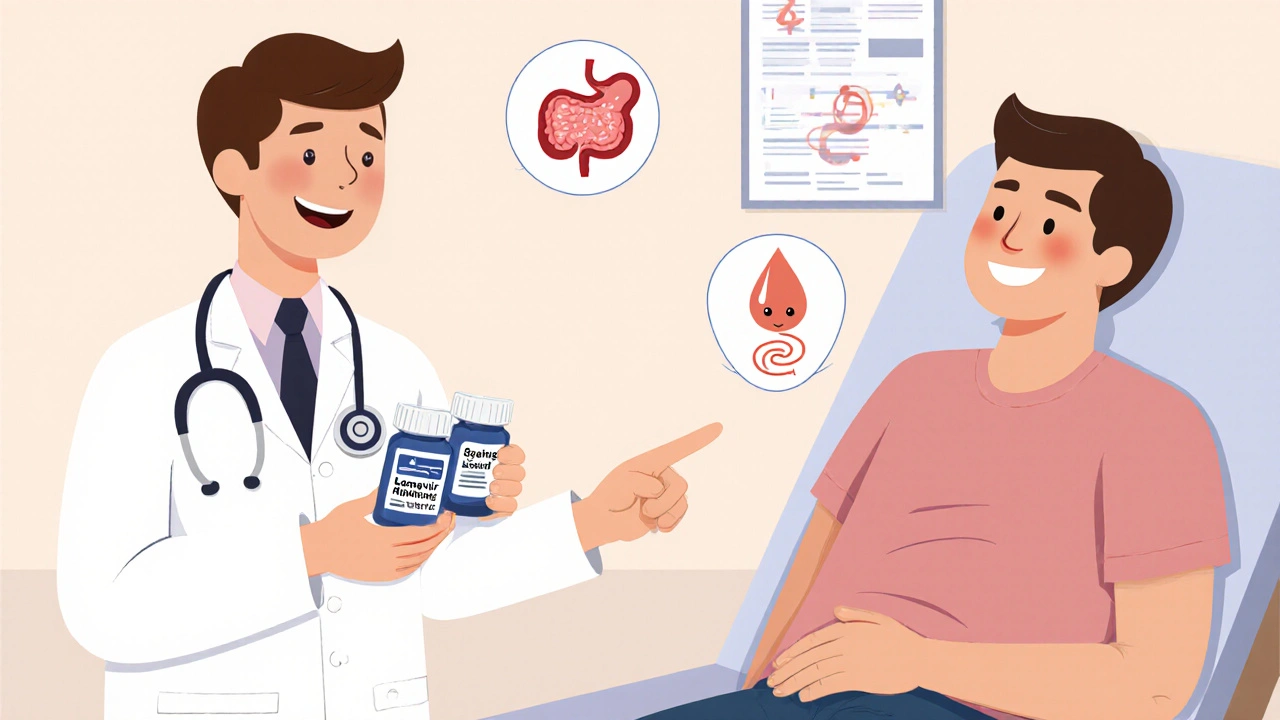Key Takeaways
- Most patients experience mild gastrointestinal symptoms, but serious issues like hepatotoxicity can occur.
- Lopinavir is metabolized by CYP3A4, so any drug that alters this enzyme can change its levels.
- Co‑administration with ritonavir boosts exposure but also raises the risk of lipid abnormalities.
- Regular monitoring of liver enzymes, lipids, and ECG is essential for safe therapy.
- When side effects appear, dose adjustment or switching to another protease inhibitor often resolves the problem.
Understanding the full safety profile of lopinavir side effects and how the drug interacts with other medicines is crucial for anyone on antiretroviral therapy. This guide walks you through the most common adverse reactions, the serious conditions to watch for, and the key drug‑drug interactions that can make or break treatment success.
What Is Lopinavir?
Lopinavir is a protease inhibitor used in combination with ritonavir to treat HIV‑1 infection. It blocks the HIV protease enzyme, preventing the virus from maturing and replicating. Lopinavir is supplied as the co‑formulated tablet Kaletra®, which pairs it with a low dose of ritonavir that acts as a pharmacokinetic booster.
Common Side Effects
Most patients notice mild symptoms within the first two weeks. These are usually manageable and do not require stopping therapy.
- Gastrointestinal upset: nausea, diarrhea, abdominal pain, and flatulence affect up to 30% of users.
- Fatigue: a sense of tiredness is reported by roughly 15% of patients.
- Loss of appetite: can lead to weight loss if prolonged.
- Headache: often mild and transient.
These effects tend to improve after the first month as the body adjusts to the medication.
Serious Adverse Events
Although less common, certain reactions demand immediate medical attention.
- Hepatotoxicity (liver enzyme elevations, hepatitis, or liver failure): occurs in 2-5% of patients, especially when combined with other hepatotoxic drugs.
- QT prolongation (lengthening of the heart’s electrical cycle that can trigger arrhythmias): risk rises when lopinavir is taken with other QT‑extending agents.
- Hyperlipidemia (elevated cholesterol and triglycerides): a direct effect of ritonavir boosting, seen in up to 20% of patients.
- Hyperglycemia (increased blood sugar that may precipitate diabetes): more common in patients with pre‑existing metabolic disorders.
- Severe skin reactions such as Stevens‑Johnson syndrome (rare, <1 in 10,000).
If any of these symptoms develop-especially jaundice, unexplained bruising, chest pain, or a rapid rise in blood sugar-contact a healthcare professional right away.
Why Do These Side Effects Occur? The Role of Metabolism
Lopinavir is extensively metabolized by the liver enzyme CYP3A4 (a key enzyme in the cytochrome P450 family responsible for breaking down many drugs). Ritonavir inhibits CYP3A4, which raises lopinavir plasma concentrations and enhances antiviral efficacy. However, this inhibition also means that other drugs using the same pathway may reach toxic levels, while drugs that induce CYP3A4 can lower lopinavir exposure, risking viral rebound.
Because of this metabolic link, the side‑effect profile of lopinavir mirrors both its own pharmacology and that of any co‑administered agents that affect CYP3A4.
Major Drug Interactions
Below is a focused list of drugs and drug classes that commonly interact with lopinavir/ritonavir. The interaction type (increase or decrease) is shown, along with the clinical consequence.
| Drug / Class | Interaction Type | Clinical Impact |
|---|---|---|
| Statins (e.g., simvastatin, lovastatin) | Increase | Risk of rhabdomyolysis; choose pravastatin or rosuvastatin at low dose. |
| Anti‑arrhythmics (e.g., amiodarone, quinidine) | Increase | Enhanced QT prolongation; monitor ECG. |
| Antifungals (ketoconazole, itraconazole) | Increase | Higher lopinavir levels; consider dose reduction. |
| Anticonvulsants (carbamazepine, phenytoin) | Decrease | Reduced lopinavir exposure; may need therapeutic drug monitoring. |
| Macrolide antibiotics (erythromycin, clarithromycin) | Increase | Potential hepatotoxicity; monitor liver enzymes. |
| Oral contraceptives | Decrease | Lower hormone levels; advise backup contraception. |
When starting or stopping any of the above, clinicians usually check lopinavir trough levels or adjust the dose (often 400 mg/100 mg twice daily as a standard, but sometimes reduced to 200 mg/50 mg). Always discuss any new prescription, over‑the‑counter product, or herbal supplement with your HIV specialist.
Managing and Mitigating Side Effects
- Baseline labs: Before initiating therapy, obtain liver function tests (ALT, AST), fasting lipid profile, fasting glucose, and a baseline ECG if you have cardiac risk factors.
- Regular monitoring: Repeat labs every 3 months during the first year, then semi‑annually. ECG should be repeated if you start a QT‑prolonging drug.
- Symptom‑driven adjustments: For persistent diarrhea, consider loperamide or a probiotic. Nausea can be eased with ondansetron or taking tablets with food.
- Lipid management: Switch to a lipid‑friendly protease inhibitor (e.g., atazanavir) or add a statin that’s not CYP3A4‑dependent.
- Liver safety: If ALT/AST rise >5 × ULN or bilirubin climbs, stop lopinavir/ritonavir and evaluate other causes (viral hepatitis, alcohol, other hepatotoxic drugs).
- Switching strategies: When side effects are intolerable, a clinician may transition to an integrase inhibitor-based regimen, which generally has fewer metabolic issues.
Special Populations
Pregnant women, children, and older adults have unique considerations.
- Pregnancy: Lopinavir/ritonavir is Category C but widely used; monitor for hyperglycemia and pre‑eclampsia.
- Children: Dosing is weight‑based; watch for growth delays if chronic diarrhea persists.
- Elderly: Polypharmacy raises interaction risk; start with the lowest effective dose and assess renal function.
Frequently Asked Questions
Can I drink alcohol while on lopinavir?
Alcohol itself does not change lopinavir levels, but heavy drinking can worsen liver enzyme elevations and increase the chance of hepatitis. Moderation is advised, and any signs of liver trouble should prompt a doctor visit.
Do I need to take lopinavir with food?
Yes. Lopinavir has low oral bioavailability; a high‑fat meal boosts absorption by up to 70%. Taking it with a snack is better than on an empty stomach.
What should I do if I miss a dose?
Take the missed dose as soon as you remember, unless it’s within 8 hours of the next scheduled dose. In that case, skip the missed one and continue with your regular schedule; never double up.
Is it safe to use herbal supplements like St. John’s Wort?
St. John’s Wort is a strong CYP3A4 inducer and can dramatically lower lopinavir concentrations, risking viral rebound. Avoid it or discuss alternatives with your clinician.
How long does it take for side effects to subside after stopping lopinavir?
Most mild symptoms improve within a few days as the drug clears (half‑life ~5 hours with ritonavir). Laboratory abnormalities may take 2-4 weeks to normalize, depending on severity.
Being aware of Drug interaction (any change in a medication’s effect caused by another substance) and monitoring for serious side effects can keep your HIV treatment on track. Talk openly with your healthcare team, report any new symptom promptly, and keep routine labs up to date. With careful management, lopinavir remains a powerful tool in the fight against HIV.



Leah Ackerson
In the grand tapestry of pharmacology, each pill is a thread that weaves our fate, and lopinavir is no exception 🌟. The side‑effects, while often mild, remind us that nothing comes without a price. Gastro‑intestinal turbulence, fatigue, and that persistent headache are like tiny philosophers whispering, “adapt, or be altered.” Yet, the deeper dangers-hepatotoxicity and QT prolongation-are the shadows that keep us honest about our choices. Remember, a high‑fat meal is a secret ally, coaxing the drug into the bloodstream like a whispered promise. And if you ever feel the rhythm of your heart stutter, it’s a signal from your body’s own metaphysics, urging you to pause and reassess. 🍃✨